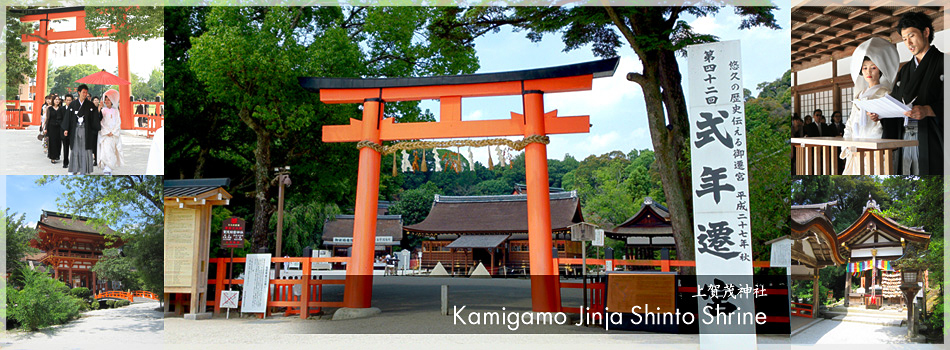
Kamigamo shrine is one of the oldest and most popular shrines in Kyoto. Located in a quiet area in northwest Kyoto, it is recognized as an UNESCO World Heritage Site and sees tens of thousands of visitors each year. Famous for its expansive grounds and sand garden featuring two symmetrical cones, Kamigamo shrine is also known for hosting the annual Aoi (hollyhocks) Festival, one of the 3 great festivals of Kyoto.
Kamigamo shrine consists of many precious buildings, including the main shrine and gonden (National Treasure) and other Important Cultural Properties. These buildings and those holding the sacred treasures are rebuilt or renovated every 21 years according to tradition since the Heian period.
Shinzen-shiki
Based on ancient Japanese customs, this is the most popular wedding ceremony in Japan. It is said that the current wedding style is based on the ceremony of the Tokyo Daijingu Shrine in Chiyoda-ward, established in cerebration of the marriage of the Taisho Emperor in 1902. The ceremony consists of the ritual exchange of sake (san-san-kudo), offering of the sakaki evergreen branch, and the vow of the bridal couple in front of the altar.
------- 130,000yen(100,000yen"Ceremony fee"+30,000yen"photography in the precincts" )
------- 200,000yen (Separately from Ceremony fee)
Plan includes:
- Planning fee (questions,requests,consultations,etc)
- Ceremony attending staff cost (attending at the wedding day,deal of taxi,etc)
- Interpretation in English (into the shrine and temple)
------- 320,000yen
Plan includes:
- White shiromuku kimono for the bride
- Black montsuki kimono and hakama for the groom
- Kimono dressing and attendant during ceremony
- Professional make-up and hair styling
- Undergarments for the bride
- Tabi socks and sandals for bridal couple
- English interpretation( for dressing kimono and make-up and hair styling)
Approx. 45 minutes
* Limited to weekdays
For more information on the wedding ceremony, please see our
Shinto Wedding Ceremony Guide
.
Model Wedding Schedule
(all times are approximate)
Day 1: Pre-wedding consultation – choose kimono (1 hour)
Day 2: Hair / make-up / kimono dressing (2 hours) – move to shrine (30 minutes) – ceremony preparations (20 minutes) – ceremony (45 minutes) – photography at shrine (30 minutes) – move from shrine (30 minutes) – change from kimono

Historical Background
Kamigamo shrine, famous for its two-storied romon gate and tamahashi bridge, was established in 745AD as a prayer for the Emperor’s health. Since then, all major national rituals have taken place here, including offerings and prayers. In 807, Kamigamo shrine was given a status only second to Ise shrine. The main shrine and the vermillion two-storied gate and other buildings were rebuilt in 1828. The tamahashi bridge in front of the two-storied romon gate is a designated Important Cultural Property.
After passing by the sand garden and second torii gate, in front of you are two beautiful cones made of white sand and behind them stands the front shrine. The sand cones symbolize the mountain of the deity” and is the object of worship at the shrine. It said that the deity resides here when on earth.
What is Kamo Mythology?
Back in mythological times, resident deities gave rise to the Kamo families of the region. The origin is that one day, Princess Tamayori was purifying her body in what is now known as the Kamo river. She found a red arrow floating in the water and took it back home. Eventually, through the miraculous power of the arrow, she gave birth to a son. His name was Kamo-wake-ikazuchi-no-kami.
Sometime afterwards, the body’s grandfather held a banquet and invited all of the local deities. During the feast, the grandfather asked him to raise a glass to the one he recongized as his father. The boy replied that his father lives in the high plain of Heaven. It is said that later on, Wake-Ikazuchi made his way up to Heaven, becoming the great deity of thunder, lightning, and rain.
One day his mother, Princess Tamayori, had a dream about her son, who left a message for her: “When you see me once more, please perform a formal ceremony, decorating it with hollyhocks. Thereafter I will come to earth. Later, when they performed the ceremony as requested, Wake-Ikazuchi descended to Koyama, the sacred mountain of Kamo.
To this day, with some historical interruptions, the Aoi Festival is the ritual that originates with this story. In an effort to bring auspicious weather and good favor to the region, Kamigamo shrine priests entreat the deity Wake-Ikazuchi for the Peace. Special access to this important deity was the key to this region’s importance, and the Kamigamo shrine’s main significance in Japanese history. The Divine deity Wake-Ikazuchi is enshrined in the main sanctuary called the Honden.
See Sample Schedule up to Wedding Date



